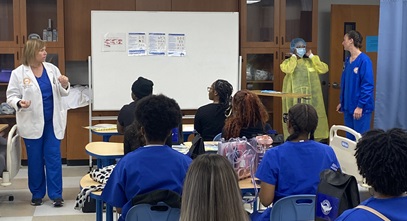Public transportation provides many mobility, safety, and economic benefits to people and businesses. Beyond those key benefits, it also offers significant environmental advantages that contribute to a better quality of life.
“Public transportation reduces the number of cars in street (makes the alleviate traffic congestion wording more redundant), and thus helps improve air quality, alleviate traffic congestion, and noise,” says Federal Transit Administration (FTA) officials.
According to the FTA, Americans take 10 billion trips on public transportation each year.
FTA for Public Transportation
“Public transportation helps increase the productivity of labor by reducing travel time and out-of-the-pocket costs of commuters in congested areas,” according to FTA offcials.
Public transportation also benefits those not using it because it helps reduce energy consumption, greenhouse gases and other pollutants.
The number of buses using alternative fuels (any fuel other than diesel and gas) increased significantly in the past 10 years, according to FTA officials. Only 9% of national bus fleets used alternative fuels in 2000. This number increased to 29% by the 2009, with an increase by 24% in the total number of buses.
Diesel and gas accounted for nearly 90% of all fuel consumed by buses in 2000, but by 2009 this number had dropped to 75%.
“Transit agencies have been very active in the last several years purchasing vehicles propelled by alternative fuels,” says FTA officials.
Many smaller cities are operating their public transportation systems by 100% alternative fleets, says FTA officials.
LA LA Land of Mass Transit
There are more than 2,500 clean air Metro buses, mini buses, and commuter buses, light, heavy, and subway trains, van pools, and rideshare programs available to people in the Los Angeles area, says Helen Ortiz Gilstrap, communications manager for the Los Angeles County Metropolitan Transit Authority (Metro).
Public transit services are not only available to residents living within the Los Angeles city limits.
“Both bus and rails systems reach a majority of the suburban areas,” Gilstrap says.
Gilstrap says it would be manageable for someone to live in the Los Angeles area without a car, and still have a way to get around.
“With the second largest transit property in the country, Metro’s system picks up over 1.5 million passengers per weekday,” Gilstrap says. “Metro also encourages and supports vanpooling and cycling as modes of transportation.”
Gilstrap says bike racks are available on all Metro buses.
The Benefits
Jorge Grillo, a 2009 graduate of the Master of Business Administration (MBA) degree program in Healthcare Administration at South University Online, says demographics are a big factor in a city’s public transportation system.
“A portion of the populace always benefits from public transportation” Grillo says.
He says the culture of a city has a lot to do with whether or not resident rely on public transportation to get around. “It depends on how spread out the city is and when they run,” Grillo says.
People that rely on public transportation to get around have to plan their lives out differently than those with access to a car, Grillo notes.
In addition to helping the environment and saving money, public transportation has other benefits.
Grillo says he made friends with people on a bus that he took regularly that he probably wouldn’t have met otherwise, although they lived relatively close to one another.
The Los Angeles Metro takes many different measures to ensure the safety of their riders.
“Metro contracts with the Los Angeles County Sheriff’s Department to have deputies patrol and ride the bus and rail system,” Gilstrap says. “Bomb sniffing dogs patrol all Metro train stations and transit hubs.”
Gilstrap says the Los Angeles Metro has security officers that monitor and patrol all Metro properties and stations and all buses and trains are equipped with surveillance cameras.
“Keeping the Metrorail and Metrobus system safe and clean are two top priorities for Metro,” says Washington Metropolitan Area Transit Authority (Metro) spokeswoman Cathy Asato.
The Washington, D.C., Metro also has its own police force that works 24 hours a day to ensure the safety of their passengers, employees, and facilities, Asato says.
“We encourage our riders to report any suspicious, illegal, or unsafe activity or conditions to us,” Asato says.
“We also rely on our passengers and have used public awareness campaigns to remind riders to take their trash, newspapers, and other belongings with them” Asato adds.




